

Rights and Freedoms: Change and Continuity - History - LibGuides at Xavier College. US Civil Rights Movement - History. Civil Rights - Rights and Freedoms - LibGuides at St John Paul College. What Rights? What Freedoms? - History - LibGuides at St Laurence’s College. Home - Rights and Freedoms - LibGuides at Saint Ignatius’ College Riverview. Udhr booklet en web. On Violence and Nonviolence: The Civil Rights Movement in Mississippi. Poster, printed by the Student Nonviolent Coordinating Committee, questions the role of the Mississippi State Highway Patrol in violence against blacks.Courtesy, McCain Library and Archives, University of Southern Mississippi.

Civil rights protesters encourage a boycott in Grenada, Mississippi.Courtesy, McCain Library and Archives, University of Southern Mississippi. Mississippi Valley State University students protest the decision by then-President James Herbert White to expel all students who were involved in protesting civil injustice and curriculum issues, specifically the lack of a Black Studies program.Courtesy, McCain Library and Archives, University of Southern Mississippi. Protest march for voting rights in McComb, Mississippi. Courtesy, McCain Library and Archives, University of Southern Mississippi. Montgomery Bus Boycott. International Civil Rights Center & Museum.
The U.S. Supreme Court ruled in the Dred Scott decision to deny citizenship and constitutional rights to all black people, legally establishing the race as "subordinate, inferior beings -- whether slave or freedmen. " Emancipation Proclamation issued by President Lincoln freed slaves in the Confederacy. The 13th Amendment to the United States Constitution abolished slavery. However, Southern states managed to revive slavery era codes creating unattainable prerequisites for blacks to live, work or participate in society.
Non-violence Was Key to Civil Rights Movement. The success of the of the American Civil Rights Movement and the fight for racial equality in the United States is a testament to the determination of millions of African Americans who fought against discrimination in the 1960s.

On January 20, 2014, Americans use the national holiday to recognize the efforts of the civil rights leader, Rev. Martin Luther King. Education resources for schools teachers and students - ABC Education. Civil Rights Movement: Timeline, Key Events & Leaders. The civil rights movement was a struggle for social justice that took place mainly during the 1950s and 1960s for blacks to gain equal rights under the law in the United States.
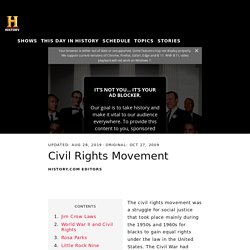
The Civil War had officially abolished slavery, but it didn’t end discrimination against blacks—they continued to endure the devastating effects of racism, especially in the South. By the mid-20th century, African Americans had had more than enough of prejudice and violence against them. They, along with many whites, mobilized and began an unprecedented fight for equality that spanned two decades. American civil rights movement - Montgomery bus boycott to the Voting Rights Act. In December 1955 NAACP activist Rosa Parks’s impromptu refusal to give up her seat to a white man on a bus in Montgomery, Alabama, sparked a sustained bus boycott that inspired mass protests elsewhere to speed the pace of civil rights reform.

After boycott supporters chose Baptist minister Martin Luther King, Jr., to head the newly established Montgomery Improvement Association (MIA), King soon became the country ’s most influential advocate of the concepts of nonviolent resistance forged by Mohandas Karamchand Gandhi. Despite the bombing of King’s house and other acts of intimidation by segregationists, MIA leaders were able to sustain the boycott until November 1956, when the NAACP won a Supreme Court order to desegregate the bus system. In 1957 King and his supporters founded the Southern Christian Leadership Conference (SCLC) to provide an institutional framework supporting local protest movements.
Rights and Freedoms - Home - LibGuides at Xavier Catholic College. The Civil Rights Movement - History - LibGuides at Loreto Mandeville Hall - Toorak. Clickview - Don't forget to search Clickview for helpful videos, as well as movies on the Civil Rights movement, like Selma.
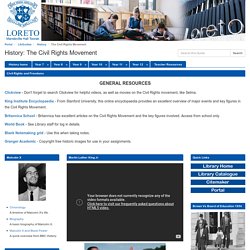
King Institute Encyclopaedia - From Stanford University, this online encyclopaedia provides an excellent overview of major events and key figures in the Civil Rights Movement. Britannica School - Britannica has excellent articles on the Civil Rights Movement and the key figures involved. Access from school only. (4) I HAVE A DREAM... MARTIN LUTHER KING - August 28, 1963. The 1960s in America: Crash Course US History #40. Civil Rights and the 1950s: Crash Course US History #39. The 1965 Freedom Ride. The students that made up SAFA came from many different existing societies including the Australian Labor Party (ALP), the Newman society, the Jewish Students Union and the Civil Liberties Association.
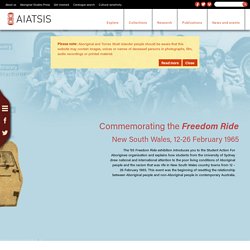
Led by Charles Perkins there were around 35 students that took part in the Freedom Ride. Note: Ages are sometimes approximate, and both age and enrolment in university courses are for February 1965. Collaborating for Indigenous Rights 1957-1973. Student Action for Aborigines was formed at the University of Sydney in 1964 The Freedom Ride through western New South Wales towns in February 1965 drew attention to the racism in these towns.
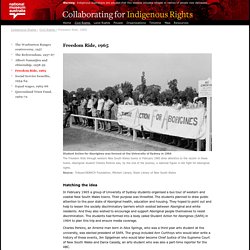
Aboriginal student Charles Perkins was, by the end of the journey, a national figure in the fight for Aboriginal rights.Source: Tribune/SEARCH Foundation, Mitchell Library, State Library of New South Wales Hatching the idea In February 1965 a group of University of Sydney students organised a bus tour of western and coastal New South Wales towns. United Nations. Australia and the Universal Declaration on Human Rights. 1301.0 - Year Book Australia, 1995. 1995, the fiftieth anniversary of the United Nations, also marks 50 years of Australian membership.
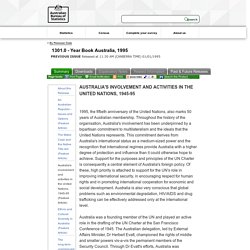
Throughout the history of the organisation, Australia's involvement has been underpinned by a bipartisan commitment to multilateralism and the ideals that the United Nations represents. This commitment derives from Australia's international status as a medium-sized power and the recognition that international regimes provide Australia with a higher degree of protection and influence than it could otherwise hope to achieve. (4) 1965 FREEDOM RIDE AWOKE NATION TO RACIAL SEGREGATION OF ABORIGINAL PEOPLE. (4) Australian Prime Minister Kevin Rudd apology speech. Indigenous and Race Issues Web Links - The Spinney Press.
Remembering 1938 'Day of Mourning' declaration. (Transcript from World News Australia Radio) In 1938 a congress of Aboriginal people met in Sydney to demand equality.
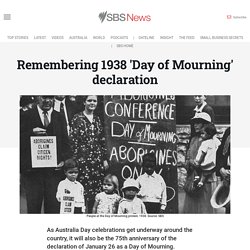
Led by William Cooper, Jack Patten and William Ferguson, they inspired generations of activists to fight for their people's rights. Stefan Armbruster reports on the historic gathering and the calls for an end to celebrations marking the arrival of the first fleet in 1788. "Things were pretty hard and they had to put up with a lot of racism.
I remember the picture show came and it was Aboriginals to the left and whites to the right, in hotels Aboriginal people drank on one side and the whites on the other, very close to apartheid. " Day of Mourning 1938. [media]On 26 January 1938, as Australians celebrated the sesquicentenary of European settlement, about 100 Aboriginal men, women and children gathered in a hall at 150–152 Elizabeth Street in Sydney, known as the Australian Hall.
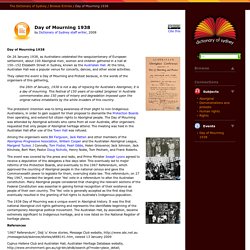
At the time, Australian Hall was a popular venue for concerts, dances, and other social activities. They called the event a Day of Mourning and Protest because, in the words of the organisers of this gathering, the 26th of January, 1938 is not a day of rejoicing for Australia's Aborigines; it is a day of mourning. This festival of 150 years of so-called 'progress' in Australia commemorates also 150 years of misery and degradation imposed upon the original native inhabitants by the white invaders of this country.
The protesters' intention was to bring awareness of their plight to non-Indigenous Australians, in order to gain support for their proposal to dismantle the Protection Boards then operating, and extend full citizen rights to Aboriginal people. History – Australia Day. (4) Living Black S2015 Ep2 - Freedom Rides. (4) Gary Williams remembers the Aborigine referendum. Walk-off at Wave Hill: Birth of Aboriginal land rights. Background of the walk-off The Wave Hill Walk-off followed more than 80 years of massacres and killings, stolen children and other abuses by early colonists. The memories of their brutal treatment over several generations weighed heavily on the minds of Gurindji people long before they walked off the station. Pastoralists who were moving into Gurindji homelands considered the blacksoil plains of the Victoria River District to be prime grazing land.
Conflicts ensued, and Aboriginal elders later remembered how white stockmen "shot them like dogs", took their women for sexual gratification or let children witness the murder of their parents or uncles. Consequently, besides being an industrial or land dispute, for Gurundji the walk-off will always also be "a pivotal moment where they chose to wrest back control of their lives after the culmination of 80 years of fear and brutality". Before the Referendum: Margaret Valadian speaks up - History (10) 00:00:12:17ROBERT MOORE:Well, it's all very well to look at the subject from the commanding heights, but how does it look from the inside? What does it mean to be an Aborigine in Australia in 1967?
How different is it? In the studio, Eric Simms, the leading points scoring in first-grade Sydney rugby league. When he's not being the South Sydney club's hero, he's a transport driver. Collaborating for Indigenous Rights 1957-1973. The 1967 referendum. On 27 May 1967, Australians voted in favour of changes to the Australian Constitution to improve the services available to Indigenous Australians. The changes focused on two sections of the Constitution, which discriminated against Aborigines. The Referendum Australia Had to Have. Australian 1967 Referendum. What was Australia's 1967 Referendum about? There are common misconceptions about what the 1967 Referendum actually changed. What the referendum was about The 1967 Referendum proposed to include Aboriginal people in the census. The 1967 Referendum proposed to allow the Commonwealth government to make laws for Aboriginal people. What the 1967 Referendum was not about.
Land rights. Aboriginal land rights. Mabo/Mabo - The Native Title Revolution. Collaborating for Indigenous Rights 1957-1973. (4) Australian Prime Minister Kevin Rudd apology speech. Kevin Rudd's national apology to Stolen Generations. Kevin Rudd's sorry speech. 'Sorry' apology to Stolen Generations. The history of the Aboriginal Tent Embassy. Timeline: Aboriginal Tent Embassy. Collaborating for Indigenous Rights 1957-1973. Aboriginal Tent Embassy, Canberra. 1946 Pilbara strike - Australia's longest strike. (4) Paul Kelly - From Little Things Big Things Grow. The Universal Declaration of Human Rights. (4) The Story of Human Rights.